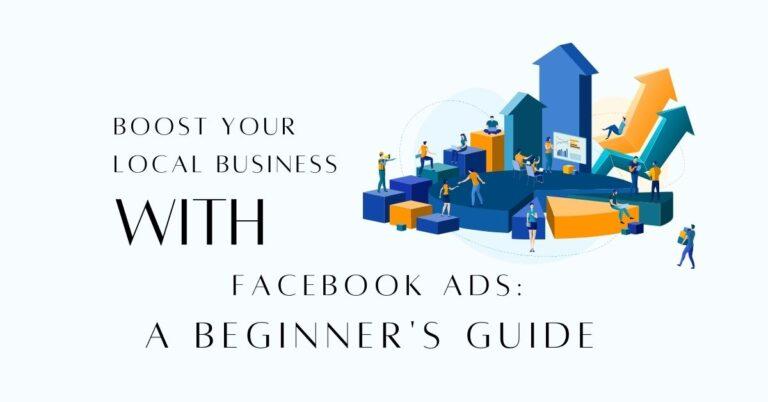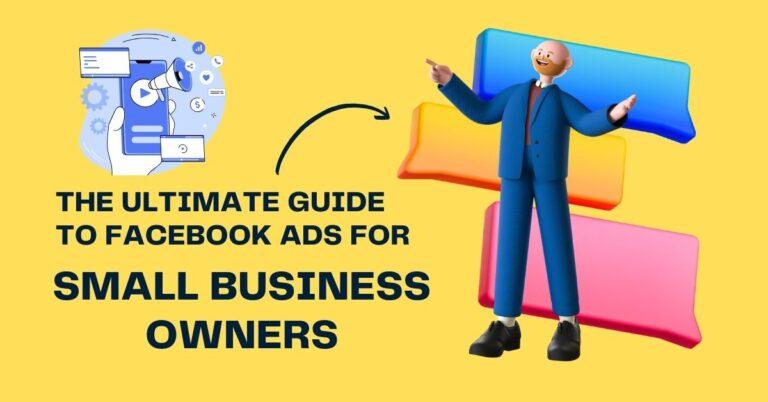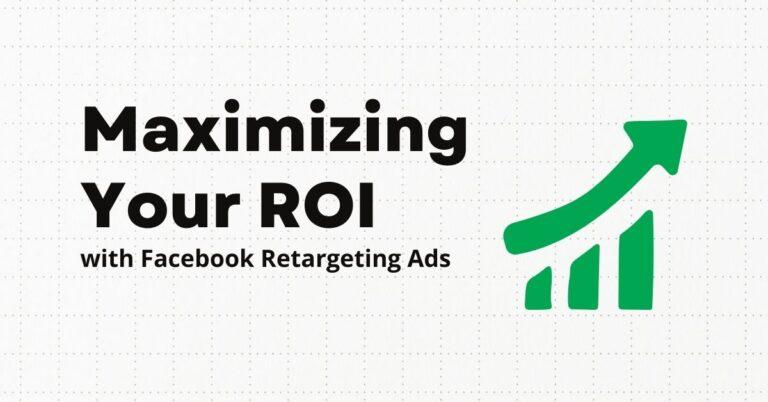As a small business owner, you are constantly looking for ways to reach a wider audience and increase your sales. In today’s digital age, one of the most effective tools at your disposal is Facebook Ads. With over 2 billion active users, Facebook provides an unparalleled platform to connect with potential customers and promote your products or services.
In this comprehensive guide, I will walk you through everything you need to know about using Facebook Ads for your small business. From understanding your target audience to creating compelling ad campaigns and measuring their success, I will cover it all. So grab a cup of coffee and get ready to dive into the world of Facebook advertising!
Key Takeaways
- Facebook Ads can help small businesses reach a wider audience and increase conversions.
- Understanding your target audience is crucial for creating effective Facebook Ad campaigns.
- Setting up a Facebook Ads account is easy and can be done in a few simple steps.
- Choosing the right ad format and crafting compelling ad copy and visuals can make a big difference in the success of your ads.
- Measuring the success of your Facebook Ads and using retargeting strategies can help increase conversions and improve long-term success.
Understanding Your Target Audience on Facebook
Before diving into creating ads on Facebook, it is crucial to understand who your target audience is. Who are the people that are most likely to be interested in what you have to offer? By identifying your target audience, you can tailor your ads specifically towards them and maximize their effectiveness.
Facebook provides a powerful tool called Audience Insights that allows you to gain valuable information about the demographics, interests, and behaviors of people on the platform. By utilizing this tool effectively, you can narrow down your target audience based on factors such as age, location, interests, and more.
Additionally, analyzing the audiences of your competitors can provide valuable insights into who might be interested in what you have to offer. Take some time to research similar businesses in your industry and see who they are targeting with their ads. This information can help guide you in defining and refining your own target audience.
Setting Up Your Facebook Ads Account
Now that we have a clear understanding of our target audience on Facebook let’s move onto setting up our ads account so we can start reaching them effectively.
The first step is creating a dedicated business page for your company on Facebook if you haven’t already done so. A business page serves as the hub for all of your Facebook advertising activities and allows you to build a community around your brand.
Once your business page is set up, it’s time to create a Facebook Ads account. This account will be linked to your business page and will serve as the platform for creating and managing your ad campaigns. Setting up an ads account is a straightforward process that requires basic information about your business and payment details.
Linking your Facebook page to your Ads account is the final step in this process. This ensures that all of the ads you create are associated with your business page, allowing you to track their performance and engage with potential customers directly from the ads themselves.
Creating Effective Facebook Ad Campaigns
| Metrics | Description |
|---|---|
| Impressions | The number of times your ad was displayed on Facebook |
| Clicks | The number of times people clicked on your ad |
| Click-through rate (CTR) | The percentage of people who clicked on your ad after seeing it |
| Cost per click (CPC) | The average cost you pay for each click on your ad |
| Conversion rate | The percentage of people who completed a desired action after clicking on your ad |
| Cost per conversion | The average cost you pay for each desired action completed by someone who clicked on your ad |
| Return on ad spend (ROAS) | The revenue generated for every dollar spent on your ad |
Now that we have our target audience defined and our ads account set up, it’s time to dive into creating effective ad campaigns on Facebook. A successful campaign starts with clearly defining its objective – what do you want to achieve with this particular set of ads?
Facebook offers several campaign objectives such as increasing brand awareness, driving website traffic, generating leads, or boosting sales. Choose the objective that aligns best with your overall marketing goals for maximum impact.
Next, it’s time to choose the target audience for your campaign. Remember the insights we gained earlier? Now is the time to put them into action by selecting specific demographics, interests, behaviors, or even custom audiences based on previous interactions with your brand.
Setting a budget and schedule for each campaign is crucial in order not to overspend or miss out on potential opportunities due to limited exposure. Start small if you’re new to advertising on Facebook and gradually increase as you see positive results.
Choosing the Right Ad Format for Your Business
Facebook offers various ad formats designed specifically for different types of businesses and objectives. Understanding these formats can help you choose which one suits best for promoting products or services effectively.
One popular format is image-based ads which allow businesses to showcase their products visually through eye-catching images. These ads are great for grabbing attention and driving engagement.
Video ads, on the other hand, provide an opportunity to tell a story or demonstrate how your product works in a more dynamic way. With the rise of video consumption on social media platforms, this format can be highly effective in capturing your audience’s attention.
Carousel ads allow you to showcase multiple products or features within a single ad unit. This format is particularly useful for e-commerce businesses looking to highlight different products or variations.
Finally, there are also lead generation ads that allow you to collect valuable customer information directly within Facebook without requiring users to leave the platform. This format is ideal for businesses looking to build their email list or generate leads for their sales team.
Crafting Compelling Ad Copy and Visuals
Now that we have chosen our ad format, it’s time to focus on crafting compelling ad copy and visuals that will capture the attention of our target audience and drive them towards taking action.
When it comes to writing effective ad copy, keep it concise and compelling. Use clear language that highlights the benefits of your product or service and creates a sense of urgency or curiosity. Personal anecdotes can be powerful here as they help create an emotional connection with your audience.
In terms of visuals, make sure they are eye-catching and relevant to your message. High-quality images or videos that showcase your product in action can significantly increase engagement with your ads. Don’t be afraid to experiment with different visuals until you find what resonates best with your target audience.
Optimizing Your Facebook Ad Budget
As small business owners, we understand the importance of making every dollar count when it comes to advertising budgets. That’s why optimizing our Facebook ad budget is crucial in order not only maximize reach but also ensure we’re getting the best return on investment (ROI).
One strategy for maximizing our ad spend is by continuously monitoring our campaigns’ performance using Facebook Ads Manager tools such as the Ads Manager dashboard and reporting features. By analyzing key metrics such as click-through rates, conversion rates, and cost per acquisition, we can identify which ads are performing well and which ones need improvement.
Another way to optimize our budget is by adjusting our bids based on performance. Facebook’s ad auction system allows us to set a maximum bid for each ad placement, ensuring that we’re not overspending while still reaching our target audience effectively.
Additionally, consider experimenting with different targeting options or ad formats to see what works best for your business. Sometimes a small tweak in your targeting strategy or creative approach can make a significant difference in the performance of your ads.
Measuring the Success of Your Facebook Ads
Measuring the success of your Facebook ads is crucial in order to understand what’s working and what needs improvement. Fortunately, Facebook provides a wide range of metrics that allow you to track and analyze the performance of your campaigns.
Some key metrics you should pay attention to include reach (the number of people who saw your ad), engagement (likes, comments, shares), click-through rate (the percentage of people who clicked on your ad), conversion rate (the percentage of people who took the desired action after clicking on your ad), and cost per acquisition (how much it costs you to acquire one customer).
By regularly monitoring these metrics and comparing them against your campaign objectives, you can gain valuable insights into how well your ads are performing and make data-driven decisions for future campaigns.
Retargeting Strategies for Increased Conversions
Retargeting is a powerful strategy that allows you to reach out specifically to people who have already shown interest in your brand or products but haven’t converted yet. By serving targeted ads only to this audience segment, you increase the chances of converting them into paying customers.
One effective retargeting strategy is creating dynamic product ads that show users specific products they have viewed on their website or added to their cart but haven’t purchased yet. This serves as a gentle reminder and can significantly increase conversion rates.
Another retargeting tactic is creating custom audiences based on specific actions users have taken on your website or app. For example, you can create an audience of people who have added items to their cart but haven’t completed the purchase and serve them ads with special discounts or incentives to encourage them to complete the transaction.
Leveraging Facebook Insights to Improve Your Ads
Facebook Insights is a powerful tool that provides valuable data about your audience, ad performance, and overall engagement with your brand. By leveraging this tool effectively, you can gain insights that will help you improve the effectiveness of your future ad campaigns.
One way to use Facebook Insights is by analyzing demographic data about your audience such as age, gender, location, and interests. This information can help you refine your targeting strategy and ensure that you’re reaching the right people with your ads.
Additionally, pay attention to engagement metrics such as likes, comments, shares, and click-through rates for each ad campaign. By identifying which ads are generating the most engagement from your target audience, you can replicate those elements in future campaigns for better results.
Tips for Long-Term Success with Facebook Ads
While running successful Facebook ad campaigns in the short term is important for immediate results; maintaining long-term success requires a different set of strategies:
Firstly it’s crucial to stay up-to-date with Facebook’s ever-changing ad platform by regularly reading industry blogs or attending webinars hosted by experts in digital marketing. This will ensure that you’re aware of any new features or updates that could impact the performance of your ads.
Secondly always be testing new ideas or approaches within your campaigns even if they seem unconventional at first glance – sometimes taking risks pays off big time!
Lastly look at successful businesses who have achieved long-term success using Facebook Ads as inspiration – what strategies did they employ? How did they adapt to changes in the platform? By studying their success stories, you can gain valuable insights that will help you achieve similar results.
In conclusion, Facebook Ads provide small businesses with a powerful tool to reach a wider audience and promote their products or services effectively. By understanding your target audience, setting up your ads account correctly, creating compelling ad campaigns, and measuring their success using Facebook Insights; you can maximize the impact of your advertising efforts.
Remember to continuously optimize your budget by monitoring performance metrics and adjusting bids as needed. Don’t be afraid to experiment with different ad formats or retargeting strategies to increase conversions. And most importantly, stay up-to-date with Facebook’s ever-changing ad platform for long-term success.
So what are you waiting for? Start using Facebook Ads today and take your small business to new heights!
FAQs
What are Facebook Ads?
Facebook Ads are a form of paid advertising on the Facebook platform that allows businesses to reach their target audience through various ad formats such as image, video, carousel, and more.
How can Facebook Ads help my small business?
Facebook Ads can help your small business by increasing brand awareness, driving website traffic, generating leads, and increasing sales. With over 2 billion active users on Facebook, it provides a large audience for businesses to reach.
What is the cost of Facebook Ads?
The cost of Facebook Ads varies depending on the ad format, target audience, and bidding strategy. Facebook Ads operate on an auction-based system, where businesses bid for ad placement. The cost can range from a few cents to several dollars per click or impression.
How do I create a Facebook Ad?
To create a Facebook Ad, you need to have a Facebook Business Page and an Ad Account. From there, you can choose your ad format, target audience, budget, and bidding strategy. Facebook provides a step-by-step guide to creating ads on their platform.
How do I measure the success of my Facebook Ads?
Facebook provides various metrics to measure the success of your ads, such as reach, engagement, clicks, conversions, and more. You can track these metrics through Facebook Ads Manager and adjust your ad strategy accordingly.
What are some best practices for Facebook Ads?
Some best practices for Facebook Ads include targeting a specific audience, using eye-catching visuals, keeping the ad copy concise, testing different ad formats and messaging, and monitoring and adjusting your ad strategy regularly.
Thank you for reading! Share your experiences and questions in the comments below!




